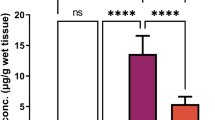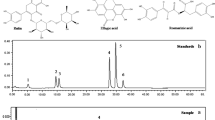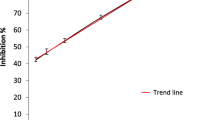Abstract
Black mulberry (Morus nigra) leaves is broadly used in traditional medicine worldwide. However, there are no scientific reports regarding testicular protection, hepato-and nephroprotective activities of M. nigra leaves. The present investigation was assessed the protective mechanism by which methanol extract from M. nigra leaves suppressed the damaging effects induced by paracetamol (APAP) in different mouse tissues. Male mice were orally given APAP (500 mg/kg) with or without M. nigra extract (150, 300, and 500 mg/kg) for four consecutive days. The results showed that crude extract possessed potent antioxidant activity (EC50 = 42.97 µg extract/mL) due to the presence of a high amount of polyphenol and flavonoid compounds. Gallic acid, chlorogenic acid, catechin, and rutin were isolated from the n-butanol fraction of M. nigra extract. Unexpectedly, oral administration of APAP did not induce chromosomal aberrations in mouse bone marrow; however, it produced damaging effects on testis, liver, and kidney tissues. Interestingly, M. nigra extract suppressed APAP-induced genotoxicity by lowering meiotic chromosomal aberrations in spermatocytes, morphological sperm abnormalities, and % DNA damage in comet tail in the liver and kidney tissues. The altered levels of glutathione S transferase activity, lipid peroxidation, liver, and kidney functions were significantly reversed when M. nigra was given to APAP group. The restoring of the histo-architectural distortions and decreasing over-expression of p53 protein as determined by immunohistochemistry in the liver, kidney, and testis sections were strengthened the protective activity of M. nigra extract. Conclusion, the bioactive components in the leaves of black mulberry appear to be a good candidate for genetic protection, treatment of oxidative stress-induced organotoxicity.







Similar content being viewed by others
References
Bergman K, Müller L, Teigen SW (1996) The genotoxicity and carcinogenicity of paracetamol: a regulatory (re)view. Mutat Res-Fund Mol Mech 349:263–288
Rannug U, Holme JA, Hongslo JK, Srám R (1995) An evaluation of the genetic toxicity of paracetamol. Mutat Res-Fund Mol Mech 327:179–200
Ratnasooriya W, Jayakody J (2000) Long-term administration of large doses of paracetamol impairs the reproductive competence of male rats. Asian J Androl 2:247–255
Hinson JA, Roberts DW, James LP (2010) Mechanisms of acetaminophen-induced liver necrosis. Handb Exp Pharmacol 196:369–405
McGill MR, Williams CD, Xie Y, Ramachandran A, Jaeschke H (2012) Acetaminophen-induced liver injury in rats and mice: comparison of protein adducts, mitochondrial dysfunction, and oxidative stress in the mechanism of toxicity. Toxicol Appl Pharmacol 264:387–394
Vijayan K, Tikader A, Weiguo Z, Nair CV, Ercisli S, Tsou C-H (2011) Morus. In: Kole C (ed) Wild crop relatives: genomic and breeding resources: tropical and subtropical fruits. Springer, Berlin Heidelberg, Berlin, Heidelberg, pp 75–95
Özgen M, Serçe S, Kaya C (2009) Phytochemical and antioxidant properties of anthocyanin-rich Morus nigra and Morus rubra fruits. Sci Horticult 119:275–279
Kandylis K, Hadjigeorgiou I, Harizanis P (2009) The nutritive value of mulberry leaves (Morus alba) as a feed supplement for sheep. Trop Anim Health Prod 41:17–24
Srivastava S, Kapoor R, Thathola A, Srivastava RP (2003) Mulberry (Morus alba) leaves as human food: a new dimension of sericulture. Int J Food Sci Nutr 54:411–416
Bagachi A, Semwal A, Bharadwaj A (2013) Traditional uses, phytochemistry and pharmacology of Morus alba Linn.: a review. J Med Plants Res 7:461–469
Hussain F, Rana Z, Shafique H, Malik A, Hussain Z (2017) Phytopharmacological potential of different species of Morus alba and their bioactive phytochemicals: a review. Asian Pac J Trop Biomed 7:950–956
Chan EW, Lye PY, Wong SK (2016) Phytochemistry, pharmacology, and clinical trials of Morus alba. Chin J Nat Med 14:17–30
Gryn-Rynko A, Bazylak G, Olszewska-Slonina D (2016) New potential phytotherapeutics obtained from white mulberry (Morus alba L.) leaves. Biomed Pharmacother 84:628–636
Diab KA (2016) In vitro studies on phytochemical content, antioxidant, anticancer, immunomodulatory, and antigenotoxic activities of lemon, grapefruit, and Mandarin citrus peels. Asian Pac J Cancer Prev 17:3559
Fahmy MA, Diab KA, Abdel-Samie NS, Omara EA, Hassan ZM (2018) Carbon tetrachloride induced hepato/renal toxicity in experimental mice: antioxidant potential of Egyptian Salvia officinalis L. essential oil. Environ Sci Pollut Res 25:27858–27876
Paget G, Barnes J (1964) Toxicity tests evaluation of drug activities. Pharmacometrics 1:135–165
Bousquet E, Marrazzo A, Puglisi G, Spadaro A, Tirendi S (1996) Synthesis, physical properties, toxicological studies and bioavailability of l-pyroglutamic and l -glutamic acid esters of paracetamol as potentially useful prodrugs. J Pharm Pharmacol 48:479–485
Diab KA, Fahmy MA, Hassan ZM, Hassan EM et al (2018) Genotoxicity of carbon tetrachloride and the protective role of essential oil of Salvia officinalis L. in mice using chromosomal aberration, micronuclei formation, and comet assay. Environ Sci Pollut Res 25:1621–1636
Wang M, Simon JE, Aviles IF, He K et al (2003) Analysis of antioxidative phenolic compounds in artichoke (Cynara scolymus L.). J Agric Food Chem 51:601–608
Harborne JB (1988) The flavonoids: advances in research since 1980. Springer, Boston
Lee TH, Chiou JL, Lee CK, Kuo YH (2005) Separation and determination of chemical constituents in the roots of Rhus javanica L. var. roxburghiana. J Chin Chem Soc 52:833–841
Kim JH, Byun JC, Hyun C-G, Lee NH (2009) Compounds with elastase inhibition and free radical scavenging activities from Callistemon lanceolatus. J Med Plants Res 3:914–920
Arabshahi-Delouee S, Urooj A (2007) Antioxidant properties of various solvent extracts of mulberry (Morus indica L.) leaves. Food Chem 102:1233–1240
Hantson P, de Saint-Georges L, Mahieu P, Leonard ED et al (1996) Evaluation of the ability of paracetamol to produce chromosome aberrations in man. Mutat Res 368:293–300
Oshida K, Iwanaga E, Miyamoto-Kuramitsu K, Miyamoto Y (2008) An in vivo comet assay of multiple organs (liver, kidney and bone marrow) in mice treated with methyl methanesulfonate and acetaminophen accompanied by hematology and/or blood chemistry. J Toxicol Sci 33:515–524
Giri AK, Sivam SS, Khan KA (1992) Sister-chromatid exchange and chromosome aberrations induced by paracetamol in vivo in bone-marrow cells of mice. Mutat Res 278:253–258
Severin E, Beleuta A (1995) Induction of chromosome aberrations in vivo in bone-marrow cells of mice by paracetamol. Rom J Morphol Embryol 41:117–120
Salah S, Abdouh S, Booles H (2012) Effect of Zingiber Officinale on paracetamol-induced genotoxicity in male rats. J Med Plants Res 6:5425–5434
Oliveira AMd, Fd NM, Ferreira MRA et al (2016) Evaluation of acute toxicity, genotoxicity and inhibitory effect on acute inflammation of an ethanol extract of Morus alba L. (Moraceae) in mice. J Ethnopharmacol 194:162–168
Li Y, Zhang X, Liang C, Hu J, Yu Z (2018) Safety evaluation of mulberry leaf extract: acute, subacute toxicity and genotoxicity studies. Regul Toxicol Pharmacol 95:220–226
Abedi N, Nabi A, Mangoli E, Talebi AR (2017) Short and long term effects of different doses of paracetamol on sperm parameters and DNA integrity in mice. Middle East Fertil Soc J 22:323–328
Aksu EH, Ozkaraca M, Kandemir FM, Omur AD, Eldutar E, Kucukler S, Comakli S (2016) Mitigation of paracetamol-induced reproductive damage by chrysin in male rats via reducing oxidative stress. Andrologia 48:1145–1154
El-Maddawy ZK, El-Sayed YS (2018) Comparative analysis of the protective effects of curcumin and N-acetyl cysteine against paracetamol-induced hepatic, renal, and testicular toxicity in Wistar rats. Environ Sci Pollut Res 25:3468–3479
Wiger R, Hongslo JK, Evenson DP, De Angelis P, Schwarze PE, Holme JA (1995) Effects of acetaminophen and hydroxyurea on spermatogenesis and sperm chromatin structure in laboratory mice. Reprod Toxicol 9:21–33
Akmal M, Aulanni'am A, Widodo MA, Sumitro SB, Purnomo BB (2016) The important role of protamine in spermatogenesis and quality of sperm: a mini review. Asian Pac J Reprod 5:357–360
Yeung CH, Tüttelmann F, Bergmann M, Nordhoff V, Vorona E, Cooper TG (2009) Coiled sperm from infertile patients: characteristics, associated factors and biological implication. Human Reprod 24:1288–1295
Olaniyi K, Agunbiade T (2018) α-tocopherol attenuates acetaminophen-induced testicular dysfunction in adult male rats. Int J Health Allied Sci 7:6–11
Sofikitis N, Giotitsas N, Tsounapi P, Baltogiannis D, Giannakis D, Pardalidis N (2008) Hormonal regulation of spermatogenesis and spermiogenesis. J Steroid Biochem Mol Biol 109:323–330
Banihani SA (2018) Effect of paracetamol on semen quality. Andrologia 50(1):e12874
Wang Y et al (2015) Hepato-protective effect of resveratrol against acetaminophen-induced liver injury is associated with inhibition of CYP-mediated bioactivation and regulation of SIRT1-p53 signaling pathways. Toxicol Lett 236:82–89
Borude P, Bhushan B, Chavan H, Weemhoff JL, Jaeschke H, Krishnamurthy P, Apte U (2017) P53 regulates progression of injury and liver regeneration after acetaminophen overdose. FASEB J 31:531–538
Hajizadeh MR, Eftekhar E, Zal F, Jafarian A, Mostafavi-Pour Z (2014) Mulberry leaf extract attenuates oxidative stress-mediated testosterone depletion in streptozotocin-induced diabetic rats. Iran J Med Sci 39:123–129
Olusoji MJ, Oyeyemi OM, Asenuga ER, Omobowale TO, Ajayi OL, Oyagbemi AA (2017) Protective effect of gallic acid on doxorubicin-induced testicular and epididymal toxicity. Andrologia 49:e12635
Oyagbemi AA, Omobowale TO, Saba AB, Adedara IA, Olowu ER, Akinrinde AS, Dada RO (2016) Gallic acid protects against cyclophosphamide-induced toxicity in testis and epididymis of rats. Andrologia 48:393–401
Salem EA, Salem NA, Hellstrom WJ (2017) Therapeutic effect of ozone and rutin on adriamycin-induced testicular toxicity in an experimental rat model. Andrologia 49:e12603
Sloczynska K, Powroznik B, Pekala E, Waszkielewicz AM (2014) Antimutagenic compounds and their possible mechanisms of action. J Appl Genet 55:273–285
Abraham SK, Sarma L, Kesavan PC (1993) Protective effects of chlorogenic acid, curcumin and beta-carotene against gamma-radiation-induced in vivo chromosomal damage. Mutat Res 303:109–112
Patil SL, Rao NB, Somashekarappa HM, Rajashekhar KP (2014) Antigenotoxic potential of rutin and quercetin in Swiss mice exposed to gamma radiation. Biomed J 37:305–313
Shruthi S, Shenoy KB (2018) Genoprotective effects of gallic acid against cisplatin induced genotoxicity in bone marrow cells of mice. Toxicol Res 15:951–958
Tanaka R (2000) Protective effects of (−)-epigallocatechin gallate and (+)-catechin on paraquat-induced genotoxicity in cultured cells. J Toxicol Sci 25:199–204
Huang W, Wang Y, Jiang X, Sun Y, Zhao Z, Li S (2017) Protective effect of flavonoids from Ziziphus jujuba cv. Jinsixiaozao against acetaminophen-induced liver injury by inhibiting oxidative stress and inflammation in mice. Molecules 22(10):1781
Shi CX, Lin YX, Liu FP et al (2017) Hepatoprotective effects of ethanol extracts from Folium syringae against acetaminophen-induced hepatotoxicity in vitro and in vivo. J Chin Med Assoc 80:623–629
Yoshioka H, Usuda H, Fujii H, Nonogaki T (2017) Sasa veitchii extracts suppress acetaminophen-induced hepatotoxicity in mice. Environ Health Prev Med 22:54
Costa S, Utan A, Cervellati R, Speroni E, Guerra MC (2007) Catechins: natural free-radical scavengers against ochratoxin A-induced cell damage in a pig kidney cell line (LLC-PK1). Food Chem Toxicol 45:1910–1917
Delgado ME, Haza AI, Garcia A, Morales P (2009) Myricetin, quercetin, (+)-catechin and (−)-epicatechin protect against N-nitrosamines-induced DNA damage in human hepatoma cells. Toxicol In Vitro 23:1292–1297. https://doi.org/10.1016/j.tiv.2009.07.022
Katanić J, Matić S, Pferschy-Wenzig EM et al (2017) Filipendula ulmaria extracts attenuate cisplatin-induced liver and kidney oxidative stress in rats: in vivo investigation and LC-MS analysis. Food Chem Toxicol 99:86–102
Tag HM (2015) Hepatoprotective effect of mulberry (Morus nigra) leaves extract against methotrexate induced hepatotoxicity in male albino rat. BMC Complement Altern Med 15:252
Rasool MK, Sabina EP, Ramya SR (2010) Hepatoprotective and antioxidant effects of gallic acid in paracetamol-induced liver damage in mice. J Pharm Pharmacol 62:638–643
Khan RA, Khan MR, Sahreen S (2012) CCl4-induced hepatotoxicity: protective effect of rutin on p53, CYP2E1 and the antioxidative status in rat. BMC Complement Altern Med 12:178
Bektur NE, Sahin E, Baycu C, Unver G (2016) Protective effects of silymarin against acetaminophen-induced hepatotoxicity and nephrotoxicity in mice. Toxicol Ind Health 32:589–600
Roh T, De U, Lim SK et al (2018) Detoxifying effect of pyridoxine on acetaminophen-induced hepatotoxicity via suppressing oxidative stress injury. Food Chem Toxicol 114:11–22
Rice-Evans CA, Miller NJ, Paganga G (1996) Structure-antioxidant activity relationships of flavonoids and phenolic acids. Free Radic Biol Med 20:933–956
Erlejman AG, Verstraeten SV, Fraga CG, Oteiza PI (2004) The interaction of flavonoids with membranes: potential determinant of flavonoid antioxidant effects. Free Radic Res 38:1311–1320
Domitrovic R, Cvijanovic O, Susnic V, Katalinic N (2014) Renoprotective mechanisms of chlorogenic acid in cisplatin-induced kidney injury. Toxicology 324:98–107
Acknowledgements
The authors would like to express their depth gratitude to all members of the Department of Microbial Biotechnology for the kind cooperation and facility to work on the fluorescent microscope and imaging.
Funding
This research work was funded by the in-house project (No. 11010345) for the eleventh research plan (2017–2019), National Research Centre, Cairo, Egypt.
Author information
Authors and Affiliations
Corresponding author
Ethics declarations
Conflict of interest
The authors declare they have no conflict of interest.
Ethical approval
The study protocol was approved by the Medicinal Research Ethics Committee of the National Research Centre as part of the project protocol under registration number (16210). All animal procedures were carried out as per the guidelines of Committee for Care and Use of Laboratory Animals of at National Research Centre (Cairo, Egypt).
Additional information
Publisher's Note
Springer Nature remains neutral with regard to jurisdictional claims in published maps and institutional affiliations.
Rights and permissions
About this article
Cite this article
Diab, K.A., Fahmy, M.A., Hassan, E.M. et al. Inhibitory activity of black mulberry (Morus nigra) extract against testicular, liver and kidney toxicity induced by paracetamol in mice. Mol Biol Rep 47, 1733–1749 (2020). https://doi.org/10.1007/s11033-020-05265-1
Received:
Accepted:
Published:
Issue Date:
DOI: https://doi.org/10.1007/s11033-020-05265-1




